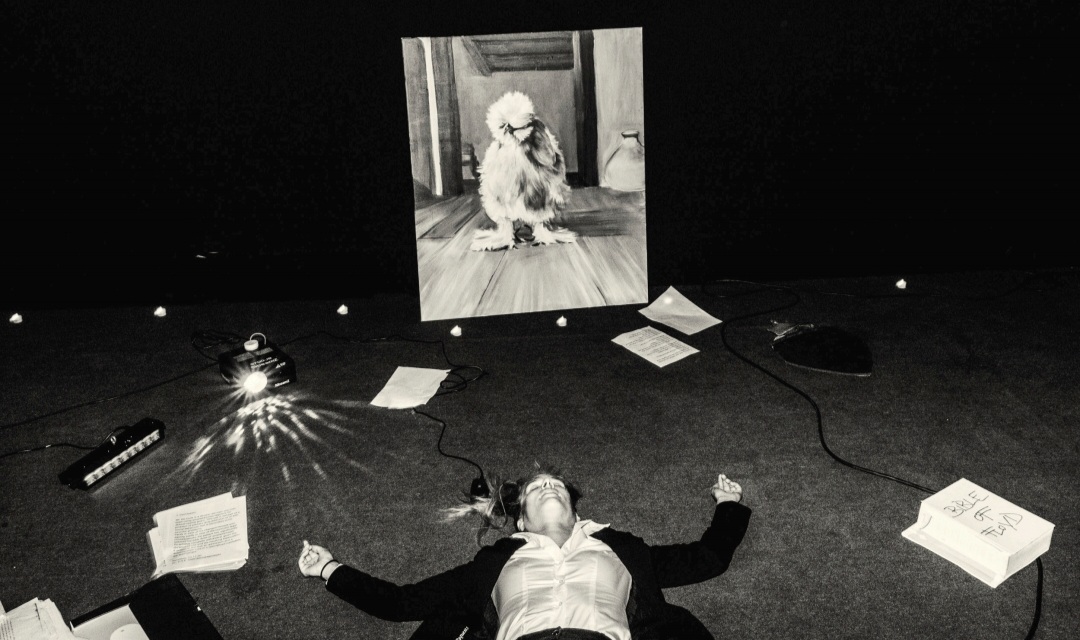StEenhouwersvest 25, 2000 Antwerpen

In 1987, the birth year of Charlotte de Cock, the then young and unknown band Skid Row first recorded their song “Floyd the Barber” at Washington student radio station KAOS.
The song was inspired by the Andy Griffith Show, an American feel-good television show featuring Andy Griffith as Andy Allen, the sheriff of a very typical American village, living with his son in Aunt Bee’s house, somewhere in North Carolina.
The band’s lead singer, Kurt, wrote the song while imagining himself getting a shave at the local saloon of Floyd the Barber. But after sitting down in the chair, he is raped and urinated on by Floyd, dismembered by Opie and Aunt Bee and suffocated by Andy Allan.
In 2019, Antwerp-based painter Charlotte De Cock started an ambitious series of 365 paintings based on the life of her tame silk chickens, The Floyds. Over the years, the Floyds appeared in various settings, resembling the artist’s own life. Sometimes sober, sometimes drunk, sometimes happy, sometimes sad, sometimes painted pink, sometimes alone and sometimes together. Each painting has a title and a subtitle, written by the artist, and reads like a diary of the Floyds’ life. Periodically, Charlotte de Cock invited friends and art lovers to her studio to meet her silkie chickens in person and present the paintings she made of them.
Kurt’s life was defined by the oppressive trauma of his parents’ divorce when he was nine, and a relentless desire to start a family. He took his art (as he would call his music and writing) extremely seriously and wanted everything he produced to be as precise as possible. It is hard not to imagine his transformation of the family characters in “Floyd the Barber” into a gang of murderous monsters as a way of dealing with his childhood traumas by projecting them onto these rather one-dimensional, American family characters.
In 2021, Charlotte did a series of performances, notably “Floyds Funeral” and “A Night with Floyd” that provide insight into the autobiographical projections the artist applies to Floyds paintings. In “Floyds Funeral”, the audience learns about Floyd’s suicide after a life of addiction and depression. It is only when the psychological account of Floyd’s time in prison is recited in the performance, and later when we see a large projection of a real suicide note where the writer’s name has been replaced with “Floyd”, that we begin to understand that the artist could actually be telling us about the traumatic disappearance of her own father, who shot himself in the head when the artist was 4 years old, and how the Floyds are a way of coping with life, the big and the small things, and processing her personal traumas through painting. In the series, The Floyds go through ups and downs, appearing at parties, in front of the mirror, in moments of isolation, in the artist’s studio or just walking around wondering.
In an opposite direction to what Kurt did to Floyd the Barber, Charlotte de Cock tries to deal with her own demons by turning them into cute furry pets who live an everyday life not dissimilar to life on the Andy Griffith Show.
When Charlotte was 7 years old, in April 1994, Kurt was found after shooting himself in the head. Nearby, a TV was found tuned to the channel that had been broadcasting reruns of the Andy Griffith Show all evening.
At the end of the show “A night with Floyd”, Charlotte held a cardboard gun to her head and shocked the audience by pretending to shoot herself. The stage went dark and the last thing viewers could see was a proud Floyd painting standing behind the artists’ body lying on stage.

ArtDependence Magazine is an international magazine covering all spheres of contemporary art, as well as modern and classical art.
ArtDependence features the latest art news, highlighting interviews with today’s most influential artists, galleries, curators, collectors, fair directors and individuals at the axis of the arts.
The magazine also covers series of articles and reviews on critical art events, new publications and other foremost happenings in the art world.
If you would like to submit events or editorial content to ArtDependence Magazine, please feel free to reach the magazine via the contact page.